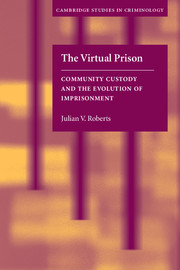Book contents
- Frontmatter
- Contents
- List of figures and tables
- Foreword by Andrew Ashworth
- Preface
- 1 Introduction to the concept of community custody
- 2 The way we punish now
- 3 Conceptualizing community custody
- 4 Representative models of community custody
- 5 Coming home to prison: offender perceptions and experiences
- 6 The effect of community custody on prison admissions
- 7 Public attitudes to community custody
- 8 Making community custody sentences work
- Notes
- References
- Index
8 - Making community custody sentences work
Published online by Cambridge University Press: 07 December 2009
- Frontmatter
- Contents
- List of figures and tables
- Foreword by Andrew Ashworth
- Preface
- 1 Introduction to the concept of community custody
- 2 The way we punish now
- 3 Conceptualizing community custody
- 4 Representative models of community custody
- 5 Coming home to prison: offender perceptions and experiences
- 6 The effect of community custody on prison admissions
- 7 Public attitudes to community custody
- 8 Making community custody sentences work
- Notes
- References
- Index
Summary
This final chapter draws upon the accumulated experience in different jurisdictions to propose ways in which community custody can be used to promote the purposes of sentencing, and attract the confidence of key criminal justice professionals (such as judges and prosecutors) as well as members of the public. These suggestions relate to the way the sanction is constructed, its range of application as well as its administration.
Locate the sanction on a scale of severity
Several steps are necessary to fix the position of the sanction on a scale of severity. First, the sanction must carry a clear ensemble of statutory conditions applicable to all offenders on the sentence. Second, although courts should have the discretion to impose additional conditions crafted to the individual circumstances of offenders, there should be limits on these discretionary conditions. Otherwise a judge could impose a raft of additional conditions and thereby move the particular sanction up the severity scale and rupture the principle of proportionality. These limits are also necessary to ensure that judges do not impose oppressive or demeaning conditions, that can be lifted only after a time-consuming delay associated with a review by an appellate court.
Third, a clear ratio should be established between time in custody and time on community custody. Judges have to ensure that the order is roughly commensurate in severity with the term of custody that otherwise would be imposed.
- Type
- Chapter
- Information
- The Virtual PrisonCommunity Custody and the Evolution of Imprisonment, pp. 154 - 184Publisher: Cambridge University PressPrint publication year: 2004



